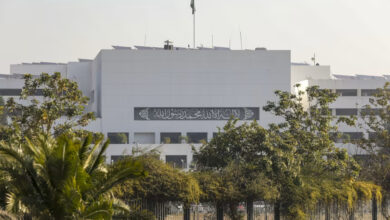Most Egyptians would agree that the 25 January revolution deserves a place in the Egyptian Museum — the most prominent and well-established museum in the country, and a fixture in Tahrir Square, the center of the protests. But allegations that the ruling armed forces used the museum building to incarcerate, violently interrogate, and abuse pro-democracy protesters has indelibly changed the site's history. Is the legacy of the Egyptian Museum, once the celebrated home of Egypt’s most prized ancient artifacts, now a “torture chamber”?
Shortly after the military stepped in to fill the void left by the withdrawal of security forces, and to put a cap on the subsequent spiraling chaos, rumors began to spread that the armed forces were detaining and abusing Tahrir Square protesters within the walls of the Egyptian Museum, which, likely due to its proximity to the square and tight security, was being used as their makeshift command center.
These accounts were particularly common during the most recent attempts by the armed forces to clear the square, when even young men and women attempting to assist soldiers found themselves captured and dragged off to the nearby museum.
Eyewitnesses to these sudden and inexplicable arrests were quick to report what they had seen, and as the news spread, public pressure guaranteed the quick release of several museum detainees, who were then able to confirm what, until then, had only been a series of distressing rumors.
“When the army began arresting people, we weren’t sure what was happening to them, or why they were being kept at the museum,” said journalist and political activist Rasha Azab. “We would go and protest these arrests outside the museum, without knowing what was happening inside.”
Azab was herself arrested and detained in the museum on 9 March. “The armed forces took me to an area directly behind the main building, where the Chamber of Tourism is located,” she said, to an area she describes as “an improvised cell block.”
Azab recalls the harsh tactics used against other detainees. “The men were being tortured with electric shocks, whips and wires,” she said. “The women were tied to fences and trees.” The earlier stages of this alarming phenomenon were marked by reports of “forced virginity tests” to which several female detainees said they were subjected.
Similar accounts have captured public attention. Ramy Essam, the 27-year-old musician known as the “Singer of the Revolution,” was also detained by military in the museum. Speaking to Al-Masry Al-Youm on a previous occasion, the artist said, “I was tortured worse than the others. I feel as though they [the armed forces] were punishing me for being called the ‘Singer of the Revolution.’”
“But I’m better now,” he insisted. “And I want to thank them for making me stronger.”
Ali Sobhy, a young actor popular within the performing arts community, was also detained at the museum. Sobhy’s case was strongly publicized by his peers, and in the face of rapidly rising public pressure, the actor was released, but not before state television erroneously identified him as one of several armed thugs attempting to harm protesters.
Since his release, Sobhy has gone public with his experience, writing a scathing and disturbing account on his blog.
Despite the testimonies of Sobhy and others, many refuse to believe that the armed forces are perpetuating the human rights abuses of the previous regime by imprisoning, torturing and humiliating protesters within the walls of the nation’s most prominent cultural landmark. But regardless of the extent of brutality allegedly taking place on its grounds, there is little doubt that the role of the Egyptian Museum has significantly shifted during the revolution, in a way that mirrors the complicated and at times contradictory nature of the current Egyptian situation.
“The museum is clearly very valuable, and precious, to the Egyptian people,” said Fayza Haikal, a professor of Egyptology at the American University in Cairo. This value, though, is double-edged. Immediately following the withdrawal of police forces, the museum was seen as a jackpot for looters, whose pilfering was largely prevented by a brigade of volunteer civilians forming a human shield around the building.
“The museum was looted more than once, especially after 28 January and 11 February. Luckily, most of what was stolen was retrieved, and all that remains missing is a few smaller artifacts," Haikal said.
“The fact that civilians took it upon themselves to defend the museum from looters is an indication of how valuable it is to Egyptians. Both in terms of our historic wealth, and as a cultural icon."
Haikal seems to be among a minority who do not think the museum’s status as a “symbol of the Egyptian people” will suffer in the face of allegations that the institution is currently doubling as a “torture camp.”
“Talk is cheap,” she said. “If these rumors are true, it would make me sad. But there are still troublemakers, and where else are authorities expected to detain these people? At the Hilton? Let’s be realistic.”
Those who were detained in the museum disagree.
“It’s a horrible way to use a cultural landmark. Its value has shifted irreversibly,” Azab said, claiming that the Egyptian Museum has gone “from one sort of symbol to another."
“It’s tragic,” she said.
“Obviously,” Ali Sobhy, speaking of his experience within the museum, said, “any form of torture is a direct violation of human rights. In this case, though, it’s also a violation of our history, culture, and civilization, and all those things that the government repeatedly taught us in school.”
The armed forces disregarded that fact, and “chose to torture Egyptians in a place that should belong more to the people than it does to the government or its military,” said Sobhy.
“In every other revolution in history, the jails used to torture protesters were later turned into museums. In Egypt, the museum has become a jail.”




